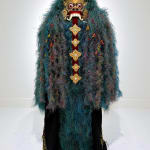



Ari Bayuaji
The Rangda, 2022
Fils en plastique. Bois, cuir, miroir, fils de plastique et de coton tissés, toile, sculptures en corail en plastique, acier / Plastic threads. Wood, leather, mirror, woven plastic and cotton threads, canvas, plastic coral sculptures, steel
70 7/8 x 17 3/4 x 19 3/4 "
180 x 45 x 50 cm
180 x 45 x 50 cm
Series: Weaving the Ocean
© Ari Bayuaji
More images
[English follows] Le 'Rangda' est une sculpture contemporaine dont près de 70 % des matériaux sont des cordes en plastique recyclées trouvées dans les forêts de mangroves et sur les...
[English follows] Le "Rangda" est une sculpture contemporaine dont près de 70 % des matériaux sont des cordes en plastique recyclées trouvées dans les forêts de mangroves et sur les plages. Elle fait partie du projet "Weaving the Ocean" (Tisser l'océan) qui a commencé pendant la pandémie, lorsque la quasi-totalité du monde était en confinement. Pendant la pandémie, Bayuaji a commencé à collecter des cordes en plastique dans les forêts de mangroves près de chez lui à Bali. Après avoir constaté que de nombreux Balinais souffraient des effets de la pandémie sur le tourisme, Bayuaji a eu l'idée d'employer de nombreuses personnes à Sanur, à Bali. Ensemble, ils ont nettoyé les cordes en plastique le long des côtes et les ont démêlées, ce qui a aidé la communauté à prospérer pendant cette période difficile.
Rangda est connue comme une reine Leyak, incarnation de Calon Arang, la sorcière légendaire qui a fait des ravages dans l'ancienne Java sous le règne d'Airlangga à la fin du 10e siècle. On dit que Calon Arang était une veuve, maîtrisant l'art de la magie noire, qui détruisait les récoltes des agriculteurs, provoquait des maladies et apportait des fléaux aux villageois.
La sculpture représente la résilience de la communauté balinaise dans les moments difficiles, grâce à l'utilisation de la nature et de leur culture pour survivre. "Tisser l'océan" est un projet en cours qui continue à se développer au fur et à mesure que les œuvres sont reconnues lors d'expositions internationales.
______
“The Rangda” is a contemporary sculpture in that almost 70% of the materials were upcycled plastic ropes found from the mangrove forests and beaches. It is part of the “Weaving the Ocean” project that was started during the pandemic when nearly the entire world was locked down. During the pandemic, Bayuaji began collecting plastic ropes from the mangrove forests near his home in Bali. After witnessing how many Balinese people were suffering due to the pandemic’s effects on tourism, Bayuaji came up with the idea to employ many people in Sanur, Bali. Together they cleaned up plastic ropes along the shores and unravelled them, which helped the community thrive during that difficult time.
Rangda is known as a Leyak queen, the incarnation of Calon Arang, the legendary witch that wreaked havoc in ancient Java during the reign of Airlangga in the late 10th century. It is said that Calon Arang was a widow, a master of the art of black magic, who destroyed farmers' crops, caused disease and brought plagues to the villagers.
The sculpture represents the resilience of the Balinese community during difficult times through the use of nature and their culture to survive. "Weaving the Ocean" is an ongoing project that continues to grow as the works gain recognition from international exhibitions.
Rangda est connue comme une reine Leyak, incarnation de Calon Arang, la sorcière légendaire qui a fait des ravages dans l'ancienne Java sous le règne d'Airlangga à la fin du 10e siècle. On dit que Calon Arang était une veuve, maîtrisant l'art de la magie noire, qui détruisait les récoltes des agriculteurs, provoquait des maladies et apportait des fléaux aux villageois.
La sculpture représente la résilience de la communauté balinaise dans les moments difficiles, grâce à l'utilisation de la nature et de leur culture pour survivre. "Tisser l'océan" est un projet en cours qui continue à se développer au fur et à mesure que les œuvres sont reconnues lors d'expositions internationales.
______
“The Rangda” is a contemporary sculpture in that almost 70% of the materials were upcycled plastic ropes found from the mangrove forests and beaches. It is part of the “Weaving the Ocean” project that was started during the pandemic when nearly the entire world was locked down. During the pandemic, Bayuaji began collecting plastic ropes from the mangrove forests near his home in Bali. After witnessing how many Balinese people were suffering due to the pandemic’s effects on tourism, Bayuaji came up with the idea to employ many people in Sanur, Bali. Together they cleaned up plastic ropes along the shores and unravelled them, which helped the community thrive during that difficult time.
Rangda is known as a Leyak queen, the incarnation of Calon Arang, the legendary witch that wreaked havoc in ancient Java during the reign of Airlangga in the late 10th century. It is said that Calon Arang was a widow, a master of the art of black magic, who destroyed farmers' crops, caused disease and brought plagues to the villagers.
The sculpture represents the resilience of the Balinese community during difficult times through the use of nature and their culture to survive. "Weaving the Ocean" is an ongoing project that continues to grow as the works gain recognition from international exhibitions.



